RootsTech Leadership Session: Family History Work Essential to God’s Plan
Contributed By R. Scott Lloyd, Church News staff writer

Elder Bradley D. Foster speaks at the Family History Leadership Session at RootsTech on March 1, 2018.
Article Highlights
- Family history and temple work is essential in God’s plan.
- Make family history and temple work a priority for lasting conversion.
- Work closely with the ward mission leader and ward temple and family history consultant.
“If I were a bishop, Primary leader, youth leader, parent, or anyone else who loves a child and wants to see him or her stay on the covenant path with the end in mind, one of my best friends would be the ward temple and family history consultant.” —Elder Dale G. Renlund of the Quorum of the Twelve Apostles
Related Links
The salvation of the whole human family is interdependent and interconnected—like the roots and branches of a great tree, said Elder Quentin L. Cook of the Quorum of the Twelve Apostles.
“Our doctrinal obligation is to our own ancestors,” said Elder Cook. “That is because the organization of heaven is families, not geography or anything else.”
Gathering God’s family on both sides of the veil and the role of temple and family history consultants in that work was the recurring concept addressed by Elder Cook and other general Church leaders March 1 at the Family History Leadership Session of RootsTech 2018.
A capacity congregation in the Conference Center Theater—and many others via live internet streaming—attended the session, primarily directed to those throughout the Church who hold the position of temple and family history consultant.
“As leaders we cannot overemphasize the importance of everyone, including the rising generation and new converts working diligently on behalf of their deceased ancestors,” said Elder Cook. “We are the Lord’s agents in this work of salvation. The combination of greatly increased numbers of temples and advanced technology for family history work make this the most blessed time in all history.”
Elder Dale G. Renlund
To be gathered, each of God’s children needs to receive—in person or vicariously—baptism and confirmation, said Elder Dale G. Renlund of the Quorum of the Twelve Apostles, who conducted the meeting and gave the first address.
“Once they are gathered by baptism and confirmation, they receive in person or vicariously the ordinances of the temple. Receiving the ordinances of the temple is something the Book of Mormon refers to as being ‘gathered into garners’ [see Alma 26:5].”
This “second gathering” provides protection from storms and fierce winds of the adversary, Elder Renlund noted from the scriptural context.
“These protections occur because those gathered are in the hands of the Lord, the harvest, and they are His, and He will raise them up at the last day,” he said.
Citing the words from President Russell M. Nelson when he addressed the membership of the Church from the Salt Lake Temple on January 16, Elder Renlund said, “We encourage everyone to get on the covenant path as soon as possible—even, especially, when they are new and tender in the gospel—and then stay focused on the blessings of the temple.”
This encouragement, Elder Renlund emphasized, is because the data are incontrovertible that young men who participate in temple and family history work have a higher rate of being ordained elders and going on missions.
“New converts who participate in temple and family history work are retained at a higher rate,” he noted.
Those who are new and tender in the gospel, he said, include 12-year-old youth and new converts. “As they are focused on temple and family history work, more will remain active, more will be protected when the storms and fierce winds strike.”
He said, “We invite all new converts and new 12-year-olds to discover and gather their families and become active participants in the plan of salvation. We desire to involve 11-year-old children and even younger children in family history work and encourage them to qualify for a limited-use temple recommend when they turn 12 years old.”
Thus, they can and are encouraged to perform proxy baptisms in temples whenever and wherever possible, Elder Renlund said.
Involvement of 12-year-olds and new converts will have a “halo effect” on all who help, he said. “Faith in the Savior of family and friends who help will increase.
“But how can we accomplish this? Ward temple and family history consultants provide the answer.”
He quoted the statement of President Russell M. Nelson given at RootsTech 2017: “If I were a missionary today, my two best friends would be the ward mission leader and the ward temple and family history consultant.”
Elder Renlund added, “If I were a bishop, Primary leader, youth leader, parent, or anyone else who loves a child and wants to see him or her stay on the covenant path with the end in mind, one of my best friends would be the ward temple and family history consultant.”
Similarly, if he were a bishop and wanted to help new converts stay on the covenant path, his best friends would include the ward mission leader and ward temple and family history consultant, he said.
Watch Elder Renlund’s full address.
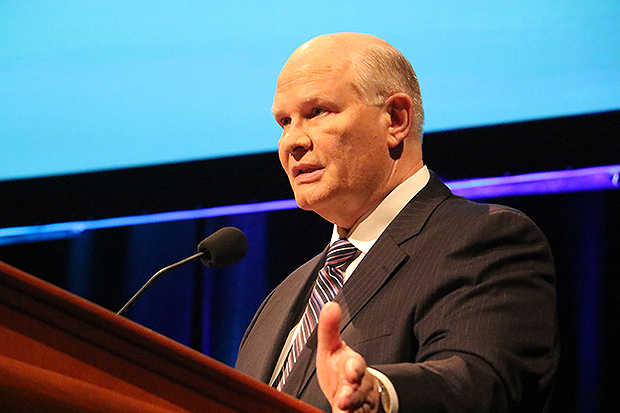
Elder Dale G. Renlund addresses the Family History Leadership Session at RootsTech on March 1, 2018. Photo by R. Scott Lloyd.
Elder Bradley D. Foster
Addressing the consultants present and watching online, Elder Bradley D. Foster said they have “one of the most exciting and profound callings in the Church.”
“Heavenly Father wants all of His children home again in families and in glory,” said Elder Foster, General Authority Seventy and Executive Director of the Family History Department. “Imagine your unique role in that plan. I’ve learned that if you want to endear someone to you, do something nice for their children. Imagine how Heavenly Father will feel about you as you are doing something nice for His children.”
Elder Foster said the consultants will help people discover their families, gather them together, and connect them to each other and to Him.
“Think of how parents and grandparents on the other side of the veil will feel about you as you help their posterity discover them, gather their stories, and connect them to each other through temple ordinances.”
He noted that the Savior ministered to people one by one “just as you will minister to those whom you have been called to serve, going to where they are. This may be in their homes, in daily activities, or in a Church setting.”
Elder Foster invited those among the estimated 80,000 temple and family history consultants around the world to learn more about their stewardship by exploring the many resources on FamilySearch.org. He recommended three new videos to be found on FamilySearch.org/calling and showed one that demonstrates how a temple and family history consultant followed the Savior’s pattern by helping one of Heavenly Father’s children who needed to be healed.
Watch Elder Foster’s full address.
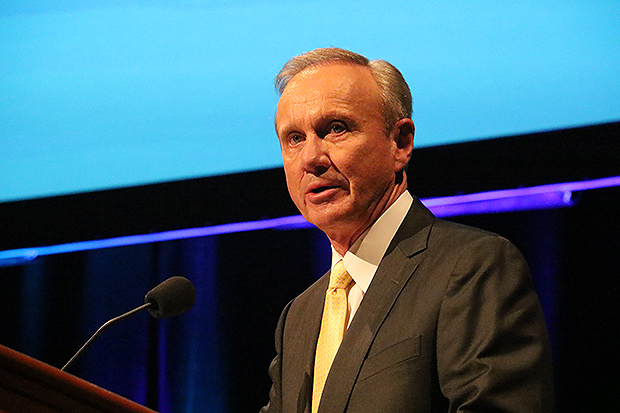
Elder Bradley D. Foster explains that we offer saving ordinances to our ancestors “one-by-one,” following the pattern of Christ’s ministry. Photo by R. Scott Lloyd.
Sister Joy D. Jones
Sister Joy D. Jones, Primary General President and a member of the Temple and Family History Executive Council, said, “Children love to learn about their ancestors. Family stories can teach them important lessons and help them develop a foundation of strength they can draw from throughout their lives.”
She remarked that temple and family history consultants can lead young people into the world of family history along with their parents and other family members.
Working with children might require different methods than working with adults, “but I promise you that it’s worth the effort and the necessary adaptations and creativity,” she said.
“Plus, it can be fun. Acting out a meaningful family story, learning about their family culture or even family recipes, viewing pictures of their relatives as children, or talking about and recording their four generations in the My Family booklet are all simple ways to begin connecting children.”
Watch Sister Jones’s full address.
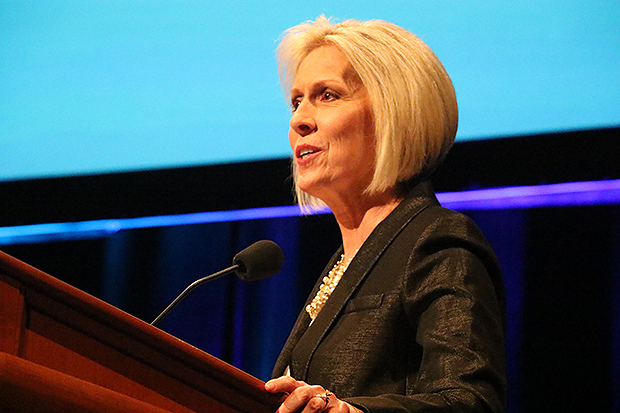
Sister Joy D. Jones encourages members to get their children involved with family history and temple work early on. Photo by R. Scott Lloyd.
Elder Donald L. Hallstrom
Elder Donald L. Hallstrom, General Authority Seventy and Executive Director of the Priesthood and Family Department, said, “As children mature spiritually, it is essential that they have personal experiences that allow them to feel the influence of the Holy Ghost.”
He said, “As children, youth, and those who are young in the gospel engage in family history research, it is easy for the Spirit to embrace them, because this work is at the heart of the gospel.”
Elder Hallstrom noted that recently the decision was made to enlarge the Priesthood Preview the Primary has long held for 11-year-old boys to Temple and Priesthood Preparation for 11-year-old boys and girls. “Boys and girls have a need to learn about the priesthood and the temple and to prepare to qualify for limited-use temple recommends, preparatory to receiving temple recommends that will for a lifetime represent the keeping of covenants.”
The ideal, he said, is that the family together researches their ancestry, connecting them with those who have come before with stories of faith, sacrifice, and perseverance. Family names are then prepared for temple ordinances. With parents and adult children holding temple recommends and youth over age 12 holding limited-use recommends, the family together attends the temple and baptismal and confirmation ordinances are performed. Other temple ordinances are subsequently performed by the adult members of the family.
What of those who don’t have the ideal circumstance? “Just do your best,” Elder Hallstrom said. “We all have a vital place in this holy process, and importantly, do not forget our children.”
Watch Elder Hallstrom’s full address.
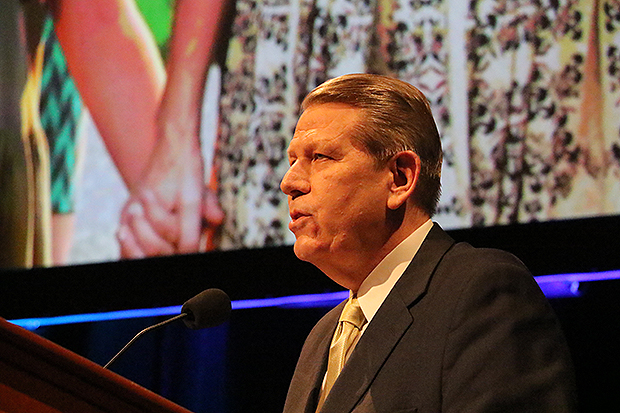
Elder Donald L. Hallstrom tells members to “just do your best” with family history and temple work, and blessings will follow. Photo by R. Scott Lloyd.
Elder Patrick Kearon
Elder Patrick Kearon of the Presidency of the Seventy spoke of his less-than-optimal experience when as a 26-year-old convert to the Church in London, he was introduced by a friend to family history.
“I remember being led along a corridor, somewhat dark, and into a room that seemed to be very poorly lit,” he said. He saw some dusty filing cabinets and antiquated machines. An individual at a desk appeared to view his entrance as an interruption.
“Instantly, I’m hearing acronyms and jargon, another foreign language after the already foreign language I had been introduced to in just joining the Church with our interesting descriptions of so many things,” he said.
“Clearly, things have changed, and they did change for me sometime later when another friend said, ‘Tell me about your family. Do you have any pictures of your parents and grandparents?’
Wonderful things started to happen inside him as a result of that later experience, he said. “At this point I realized it was just as when one of our friends is being taught about the gospel by missionaries: when it’s done with love and with the Spirit, it's one experience, and when it’s done as a technical download it’s quite another. It was just the same with my family history experience. As soon as I was being introduced with these stories and pictures, my soul was stirred and there were connections.”
Watch Elder Kearon’s full address.
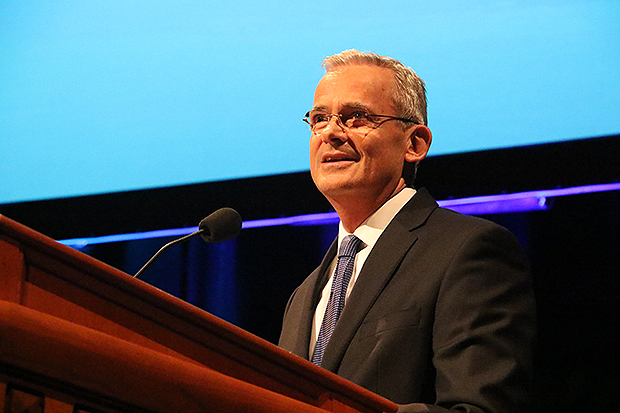
As a convert to the Church, Elder Patrick Kearon offered his insights about his first experiences with family history work and how members can enhance the experience for new members. Photo by R. Scott Lloyd.
Elder Brent H. Nielson
Elder Brent H. Nielson, General Authority Seventy and Executive Director of the Missionary Department, said, “Missionary work and family history work are one work. We are in this together.”
He added, “We make sure as soon as a new convert is baptized that they make their way quickly to the temple.”
To show how that works, he introduced Kaila Taylor of Tempe, Arizona. She found the Church by searching online. She found Mormon.org and chatted online with sister missionaries. That led to her receiving lessons from missionaries and then being baptized.
Shortly thereafter, the missionaries introduced her to the ward family history consultant. After her exposure to family history work, she told her mother and father about the gospel, and they were later baptized. They in turn were introduced to temple and family history consultants, and all went to the temple with missionaries for baptisms for their family and ancestors.
Just last month, Kaila was sealed in a temple marriage.
“It’s been a long road to get here, and one of the biggest encouragers I’ve had is being able to participate in family history and going to the temple,” she said to the congregation. “It was an incredible experience to be able to find my grandmother’s name and take her name to the temple and perform ordinances for her.”
Watch Elder Nielson’s full address.

Elder Brent H. Nielson taught that missionary work and family history work are one work. Photo by R. Scott Lloyd.
Elder Quentin L. Cook
Elder Cook, the chairman of the Temple and Family History Executive Council and the presiding officer at the meeting, offered the concluding address.
“The scriptures are clear that we without our ancestors cannot be made perfect, neither can they without us be made perfect,” he said. “Their salvation is necessary and essential to our salvation, resulting in the eternal unification of the family.”
As a seminal element of the Restoration, Elijah appeared to Joseph Smith and Oliver Cowdery in the Kirtland Temple one week after its dedication, Elder Cook said. “He committed essential keys for the eternal unification of the family, making the 110th section of the Doctrine and Covenants one of the most sacred and profound of all the revelations.”
Watch Elder Cook’s full address.
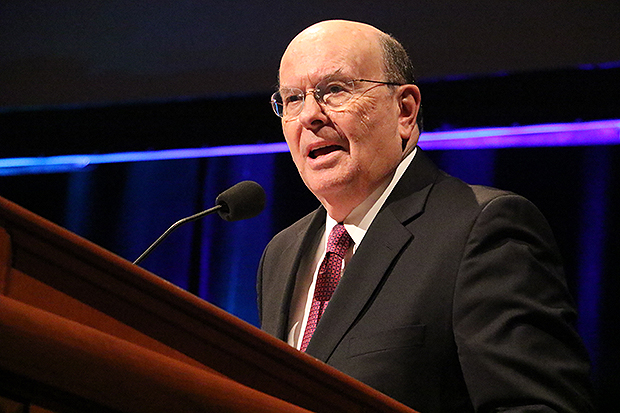
Elder Quentin L. Cook concluded the leadership session by explaining that helping our ancestors receive salvation should be a priority in our lives. Photo by R. Scott Lloyd.
The entire leadership session can be viewed online on RootsTech.org or downloadedfrom ChurchofJesusChrist.org.
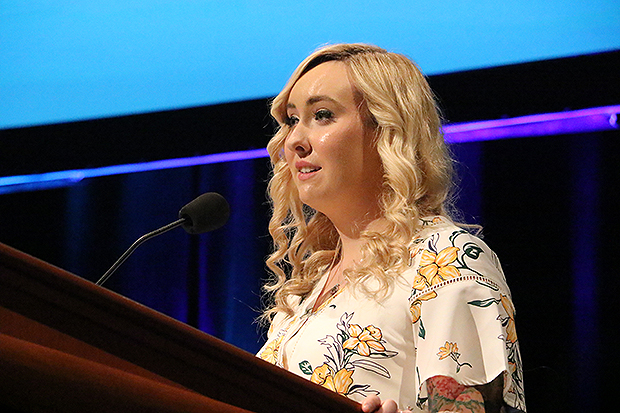
Kaila Taylor, a convert to the Church, shared how family history strengthened her testimony, led her parents to the Church, and helped her on the path to a temple marriage. Photo by R. Scott Lloyd.

Sister Joy D. Jones encourages members to get their children involved with family history and temple work early on. Photo by R. Scott Lloyd.
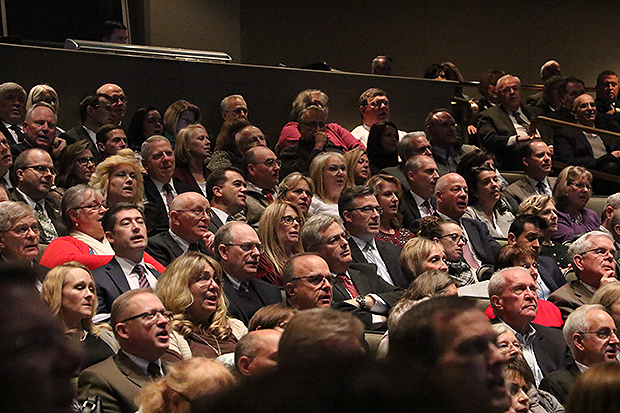
The congregation sings “Families Can Be Together Forever” during the Family History Leadership Session at RootsTech on March 1, 2018. Photo by R. Scott Lloyd.
